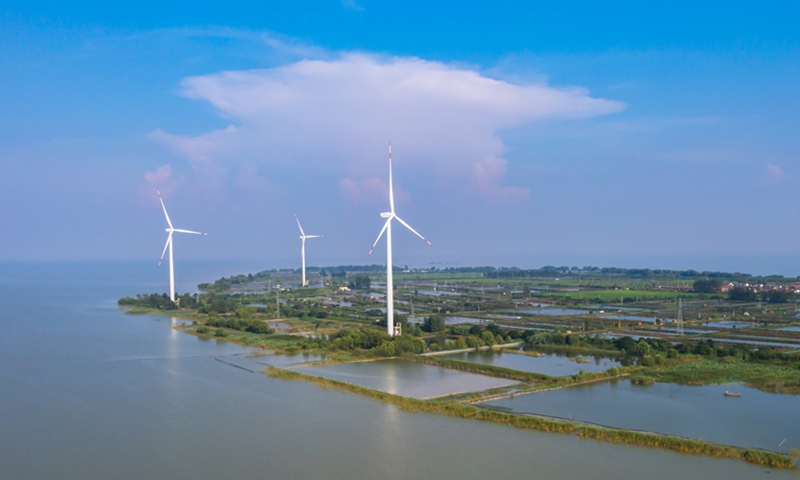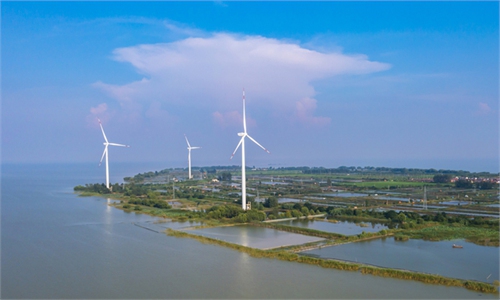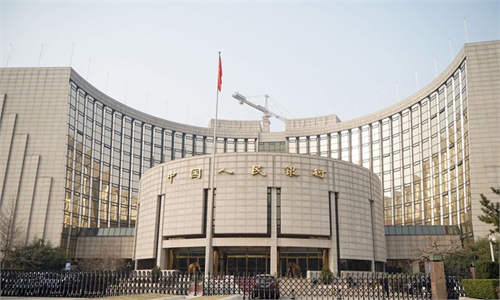China issues major clean energy plan for industries amid push to meet carbon goals
Efforts show China's commitment to climate pledges

Windmills rotate alongside a lake in Longji town, East China's Jiangsu Province on Tuesday. The project, which has 38 turbines, has a capacity of 98.1 megawatts. It has generated 633 million kilowatt-hours of electricity over the past six years, reducing carbon dioxide emissions by 1 million tons. Photo: VCG
The National Development and Reform Commission (NDRC), China's top economic planner, along with nine other government departments, on Tuesday issued a national plan for promoting clean production in several energy-intensive sectors, including industrial, agriculture, services, construction and transportation.
The plan, coming at an important juncture amid the ongoing 26th UN Climate Change Conference of the Parties (COP26) in Glasgow, also sent a clear signal on the Chinese government's unwavering determination to uphold its climate commitments, despite a global energy shortage and other current challenges.
Under the plan, China will promote a clean and low-carbon production overhaul in key industries, while accelerating the elimination of outdated capacity.
A total of 100 enterprises in sectors, including steel, petrochemicals, nonferrous metals and building materials, which generate the most carbon emissions and pollution, will be selected to take part in a pilot clean production rectification project.
In addition, China's energy and resource utilization efficiency levels also need to be significantly improved by 2025, with major pollutants and carbon dioxide emissions in key sectors dropping significantly.
The plan also explicitly highlighted accelerating cleaner efforts in the fuel sector, expanding the application of clean energy and raising the ratio of non-fossil fuels' usage. For example, during the next five years, China will actively push forward the replacement of coal, petroleum coke, heavy oil, residual oil and semi-coke with clean, low-carbon energy and industrial waste heat as fuel for industrial furnaces, coal-fired power plants and coal-fired furnaces.
Such a goal echoes a top-level design plan announced by the Central Committee of the Communist Party of China (CPC) and the State Council, China's cabinet, in early November, which set the share of non-fossil energy consumption at about 20 percent by 2025.
"The plan represents a detailed and phased implementation of China's top-level design to achieve its carbon goals. It also mobilizes the resources of a number of departments that oversee different industries to maximize the results," Ma Jun, director of the Beijing-based Institute of Public and Environmental Affairs, told the Global Times on Tuesday.
Industries involving both high energy consumption and high pollution, such as steel and nonferrous metals, are the focus of the action plan, according to Ma. He noted that steel production in China last year emitted 15 percent of the carbon emissions released in the country.
"The key is to put a lid on the unchecked expansion of high energy-consumption industries, while transforming their existing models of over-reliance on coal and other fossil fuels," Ma said, adding that reducing burning coal could be a "daunting task" for China but it is a necessary and must-win battle as the world's second-largest economy is on a trajectory to pursue green and high-quality development.
Clean production plans in the past focused more on cutting pollution, but this year, the agenda has been "coordinated" with China's carbon goals, analysts said.
Lin Boqiang, director of the China Center for Energy Economics Research at Xiamen University, told the Global Times on Tuesday that the release of the plan came at just the right moment to help remove doubts and continue hanging onto China's climate goals by pushing ahead with an energy structural upgrade.
Amid global energy shortages, uncertainty has risen about the reliability of new clean energy, Lin said, but that is "only temporary."
The plan further proves the determination of the Chinese government in achieving its carbon peak and carbon neutrality goals in the long term, despite some setbacks faced at the moment, according to Lin.
Apart from the plan on Tuesday, the People's Bank of China (PBC), the country's central bank, said on Monday that it will provide financial institutions with low-cost loans to help companies cut carbon emissions.
The PBC will provide 60 percent of the principal for loans to enterprises for carbon emissions cuts, with a one-year interest rate of 1.75 percent, and such loans can be made twice, according to a statement on the PBC's website.
The interest rate on loans made by banks and other financial institutions will be in line with the benchmark lending rate, or the loan prime rate.
Monetary policy tools will promote the development of immature technology in related industries to fill any gaps, such as in energy conservation, Ma said.
Some industry insiders predict the financial tools will be able to channel more than 1 trillion yuan ($156.4 billion) into the green market by the end of next year.



